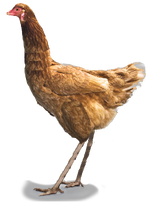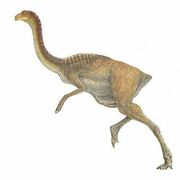
A possible restoration of an ostrich (Struthio camelus) as a fully feathered bird.
All Todays ostriches are outdated-looking ostrich species that now live in real life alongside real ostriches.
All Todays Ostrich's Description[]

An outdated restoration of an ostrich as a scaly reptile with a single clawed finger on each hand.
Fossils of these large birds have been found throughout Africa, Europe, Asia, Australia, and North America. Ostriches were once thought to be large species of emu (Dromaius novaehollandiae), but paleontologist have since disproved that theory. Ostriches were also once thought to be large bipedal reptiles related to alligators of today, having scaly skin, clawed finger on each hand, being either cold-blooded (living around 150 years) or warm-blooded (living around 60 years) depending on some studies, and being completely flightless, but recent studies inside the bones and their genomes have confirmed that ostriches were in fact large birds that walked bipedally on two long legs, having no clawed fingers and instead having wings, being either flightless or short-distance fliers (no one knows if ostriches could have flew or not), being warm-blooded (living around either 40 or 50 years), and possibly being completely feathered. It is possible that ostriches could have been completely herbivorous like today's large birds of North America and Asia, but they could have been omnivorous like crows, ravens, magpies, and jays of today, which also lived when ostriches were alive. In Asia, Europe, and North America, they built nests like today's large flightless birds such as the Cracoca (a relative of crows that is completely flightless and is native to Asian grasslands), consisting of dirt, leaves, and other materials to help keep the large grapefruit-sized eggs warm against the chilly temperatures in the Northern Hemisphere during the Holocene period. It is unknown why ostriches became extinct in the end of the Holocene period.
Introduction to real life North America[]
Ever since humans introduced all known species of all todays ostriches (flightless scaly ones, flightless slightly feathery ones, and flighted fully feathery ones) to real life North America, they now coexist alongside real ostiches. Unlike their ancestors, they are no longer aggressive towards any sapient species/beings nor dylanusids, and are now gentle and tame towards them. They are now adapting really well into the cities, towns, suburbs, and other artificial habitats.
